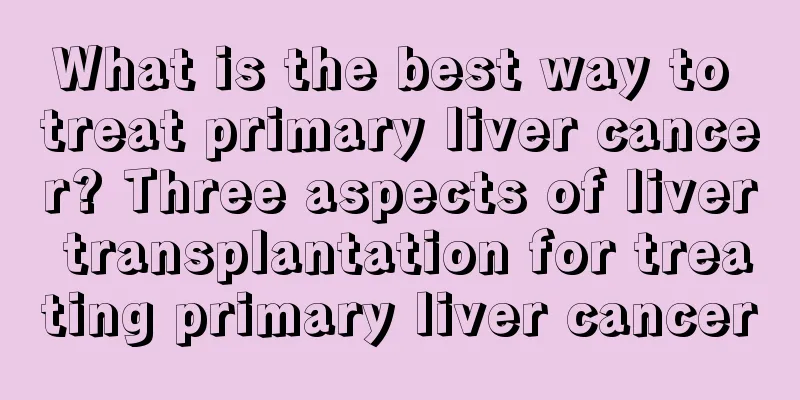What is the best way to treat primary liver cancer? Three aspects of liver transplantation for treating primary liver cancer

|
Liver cancer is not scary, the key lies in clever treatment The incidence of the king of cancer is increasing rapidly Liver cancer ranks second in incidence among cancers in my country, with 110,000 new liver cancer patients each year. This number may not be correct, with some statistics putting it at 200,000 to 400,000, and others even at 1 million. In short, our country is a major liver cancer country, accounting for 45% of the world's liver cancer mortality and incidence, nearly half. Liver cancer is not like other tumors such as gastric cancer, esophageal cancer, intestinal cancer, and lung cancer. The symptoms of these cancers can be discovered relatively early, such as obstruction when eating, blood in the stool, cough with blood in sputum, etc. Liver cancer tumors can reach 10-15 cm and there may be no feeling of it. The person will not lose weight, have a decreased appetite, and be normally active. He or she may just feel easily fatigued. Fatigue is also prone to occur when one is active and has work stress. Therefore, liver cancer is often discovered late. Once discovered, most patients lose the opportunity for surgery, and conventional radiotherapy and chemotherapy are not ideal, so effective anti-tumor treatment is often not possible. Liver cancer treatment selection is the key To treat liver cancer, at least three factors, namely, the patient's liver function, physical condition, family and economic background, must be considered. Liver function reserve is the foundation for the patient's survival, the premise for maintaining the quality of life, and is closely related to the prognosis. Surgery itself is a serious trauma to the human body, and radiotherapy and chemotherapy can also cause great damage to liver function. In addition, the high cost of conventional treatment has restricted the progress of the efficacy of liver cancer treatment. New approach - targeted therapy brings new hope The most widely used method in the treatment of liver cancer is conventional interventional therapy. However, with the continuous progress of clinical research, the disadvantages of conventional intervention have begun to emerge: conventional interventional therapy generally directly uses high-concentration chemotherapy drugs and iodized oil injections. After the drugs are injected into the artery, they are wrapped in iodized oil and have no therapeutic effect. The drugs released from the iodized oil quickly flow out through the veins and have a short residence time, which is insufficient to ensure sufficient drug concentration throughout the entire tumor cell cycle, resulting in poor effects. In 1998, a new targeted therapy technology, sustained-release depot therapy, began to be used clinically. This therapy was invented by me during my study in the United States. It uses drugs and sustained-release preparations coupled with direct percutaneous intratumoral injection. After injection, the drug stays in the tumor stroma. The drug concentration can be maintained for two to three weeks, which is enough to kill tumor cells in each cell cycle. The effect is good and there are almost no side effects. It has obtained invention patents in China, the United States, and Australia. It is suitable for various primary or metastatic solid tumors such as lung cancer, liver cancer, pancreatic cancer, esophageal cancer, gastric cancer, intestinal cancer, bladder cancer, prostate cancer, kidney cancer, oral cancer, nasopharyngeal cancer, cervical cancer, ovarian cancer, breast cancer, skin cancer, malignant lymphoma, bone tumors, etc. It is also applicable to patients who cannot or are unwilling to undergo surgery, have failed surgery, have postoperative recurrence or metastasis, and to patients who have failed chemoradiotherapy or cannot tolerate chemoradiotherapy. The sustained-release reservoir therapy is targeted to treat tumors without surgery, pain, and good results. It can prolong the patient's life, improve the quality of life, and protect the patient's dignity! Liver transplantation for primary liver cancer 1. Background With the continuous improvement of immune function suppression, the long-term survival of benign cases (mainly cirrhosis cases without liver tumors) after liver transplantation is very good. This has led to an increasing number of indications for liver transplantation, and therefore, the demand for liver transplantation and donor livers has also increased significantly. More and more patients with benign liver diseases die of liver failure while waiting for liver transplantation because they cannot wait for a donor liver. In the early stages of liver transplantation, people expected that liver tumors that were previously considered inoperable with partial liver resection could be treated with total liver resection and liver transplantation. Therefore, the cases selected for liver transplantation were often large localized advanced liver tumors. Although these patients did not have extrahepatic metastasis at the time of liver transplantation, clinical practice of liver transplantation soon showed that the vast majority of these patients died of tumor recurrence within a short period of time after surgery. The results of the study clearly showed that the suppression of immune function accelerated tumor growth and promoted tumor recurrence. Nowadays, it is difficult to justify the short-term relief of liver cancer by liver transplantation as a treatment for localized progressive liver cancer. Transplant surgeons should strictly select liver cancer cases for liver transplantation. Their goal should be very clear, that is, to use strictly selected liver cancer cases to obtain a long-term survival rate after liver transplantation similar to that of benign cases. 2. Primary Hepatocellular Carcinoma Primary hepatocellular carcinoma is the most common malignant tumor originating from the liver and is also the most common surgical indication for liver transplantation to treat malignant liver tumors. The following points need to be discussed in detail for liver transplantation to treat liver cancer. 1. Case selection for liver transplantation: Early experience with liver transplantation has clearly demonstrated that there are some factors that can affect the long-term efficacy of liver transplantation. These factors should be considered when selecting liver transplantation cases. (1) Tumor diameter: The diameter of the tumor significantly affects the long-term survival rate after liver transplantation. A recent group of 410 liver cancer cases registered and treated with liver transplantation showed that the 5-year survival rates were 59.9%, 48.7% and 32.6% for liver cancers with diameters less than 3 cm, 3-5 cm and greater than 5 cm, respectively. There is currently no consistent standard for how many centimeters the liver cancer diameter must exceed to be a contraindication for liver transplantation. However, most transplant centers limit the upper limit of liver transplantation to a single tumor diameter of no more than 5 cm. (2) Extrahepatic metastasis: Extrahepatic metastasis is an absolute contraindication for liver transplantation. (3) Vascular and lymph node invasion: Because the prognosis of liver transplantation with vascular and lymph node invasion is very poor, most transplant surgeons believe that vascular and lymph node invasion should be a contraindication to liver transplantation. (4) Hepatitis B and C: Due to the emergence of effective antiviral treatments, hepatitis B and C are no longer contraindications for liver transplantation. (5) Multiple tumor foci: Liver cancer cases with multiple foci have poor outcomes after transplantation. However, Mazzaferro et al. reported 48 liver cancer transplantation cases, in which the diameter of a single tumor did not exceed 5 cm, the diameter of multiple tumors was less than 3 cm, and the total number of tumors did not exceed 3. Their 4-year survival rate could reach 75%, while the tumor recurrence rate was only 8%. Therefore, even if there are multiple tumors, if the tumor diameter is small and the number is small, it is not a contraindication to liver transplantation. (6) Tumor tissue differentiation: Although the degree of tumor tissue differentiation has prognostic significance for liver transplantation for liver cancer treatment, patients who need liver transplantation are often unable to undergo liver tumor biopsy due to liver failure. Moreover, biopsy may cause tumor implantation, so it is not common to know the tissue differentiation of a patient's tumor before surgery. Tumor tissue differentiation can usually only serve as an indicator of postoperative prognosis. In summary, liver transplantation for liver cancer should select tumors with a diameter of no more than 5 cm, multiple tumors with a diameter of less than 3 cm, and no more than 3 tumors in total. The tumor should also be free of vascular and lymph node invasion, and no extrahepatic metastasis. If hepatitis B or C is properly treated, the 5-year survival rate can be as high as 79% (Table 1). The long-term survival rate of patients is very close to that of liver transplantation for benign end-stage cirrhosis. 2. Preoperative and postoperative adjuvant chemotherapy: Recently, liver transplant centers are increasingly inclined to combine liver transplantation with preoperative or postoperative adjuvant chemotherapy to treat liver cancer in order to improve the efficacy of liver transplantation. In theory, preoperative and postoperative adjuvant chemotherapy is in line with the principles of oncology. Previous studies have shown that during partial liver resection for cancer treatment, liver cancer cells can be found in the blood of the right atrium, portal vein or peripheral vein. Since total liver resection and liver transplantation are larger surgeries than partial liver resection, the chance of finding liver cancer cells in the extrahepatic blood should be greater. Therefore, it is a very reasonable idea to use adjuvant chemotherapy before and after surgery to eliminate tiny metastatic cancer foci. In clinical observation, tumor recurrence after liver transplantation often occurs in the transplanted liver or other parts (mainly in the lungs) in the early stage. This phenomenon suggests that micro-metastatic lesions may have existed before transplantation, or tumor spread during transplantation. These observations further support the use of preoperative and postoperative adjuvant chemotherapy to improve the efficacy of liver transplantation in the treatment of liver cancer. Unfortunately, this treatment method, which can theoretically improve the efficacy of liver transplantation, has not been supported by the treatment effects in clinical practice. Up to now, there is no conclusive evidence showing that the use of preoperative or postoperative systemic chemotherapy, or transcatheter chemoembolization (TACE), can improve the efficacy of liver transplantation in the treatment of liver cancer. 3. Immune function suppression: The suppression of immune function after liver transplantation is mainly to find a balance point. If the immune function is suppressed excessively, it may cause postoperative infection problems. If the immune function is not suppressed enough, it may cause rejection problems. Liver transplantation for liver cancer, because the suppression of immune function can have a negative effect on tumor growth and spread, so special immunotherapy countermeasures should be formulated. It is reported that if steroid preparations are discontinued 3-6 months after liver transplantation for liver cancer, the recurrence rate of liver cancer is the lowest. On the contrary, if the recipient liver receives long-term steroid treatment after surgery, the risk of liver cancer recurrence is almost increased by 4 times. Balancing the accelerated tumor growth caused by insufficient host immune function suppression and excessive suppression should be a special issue that should be considered when malignant tumors are transplanted. 4. Treatment strategies for liver cancer patients waiting for liver transplantation: Liver cancer patients usually need to wait for a period of time from diagnosis to liver transplantation. If the waiting period is only 1-2 months, no special treatment is required. Although there is not enough evidence to prove that TACE or local liver cancer therapy (such as radiofrequency or microwave treatment) before transplantation can help improve the long-term survival rate of liver transplantation. However, if the waiting time is long, these treatment measures may help slow down the growth rate of the tumor. Therefore, it may be considered for implementation. 5. Which is better, liver transplantation or partial liver resection for liver cancer? Due to the lack of randomized controlled evidence, the debate on the merits of liver transplantation or partial liver resection for liver cancer will continue. Obviously, if partial liver resection is not possible due to the anatomical location of the liver tumor or due to the presence of severe liver cirrhosis, and the patient meets the criteria for liver transplantation, liver transplantation becomes the only feasible surgical method and should be performed. The focus of the debate on which is better is mainly on which cases are suitable for both liver transplantation and partial liver resection. Evidence shows that the results of liver transplantation and partial liver resection for these cases are not much different. If we only look at cases with severe liver failure caused by liver cirrhosis, liver transplantation has a better long-term effect than partial liver resection. However, in Asian countries, due to the high incidence of liver cancer and the severe shortage of donor livers, partial liver resection is still the main method for treating liver cancer. Recently, there is a case in the literature where the donor liver was re-infected with hepatitis C after liver transplantation, causing liver cancer to regenerate in the donor liver. Therefore, it is no longer possible to use the fact that liver transplantation can prevent liver cancer recurrence as an argument that liver transplantation is superior to partial liver resection. 6. Fibrolamellar liver cancer and incidental liver cancer (incidentoma): The best treatment for liver transplantation is fibrolamellar liver cancer. The 5-year survival rate for larger liver cancers can reach 38%-50%. However, the best treatment is for liver transplantation for benign end-stage liver disease, where liver tumors are accidentally found in the transplanted liver. Preoperative imaging examinations may miss micro-cancer lesions in cirrhotic livers in up to 25%-43%. 3. Liver transplantation for other liver tumors In addition to treating primary hepatocellular carcinoma, liver transplantation is not suitable for other liver tumors, such as cholangiocarcinoma, angiosarcoma and metastatic liver tumors, because of its poor efficacy. IV. Conclusion Liver transplantation for primary hepatocellular carcinoma can achieve good long-term survival if appropriate tumor cases are carefully selected. |
>>: What are the symptoms of lung cancer? The 5 most common symptoms of lung cancer
Recommend
How long can one live without surgery for advanced colorectal cancer
How long can a patient with advanced colorectal c...
How to make homemade nail polish
Painting nails is a symbol of fashion for modern ...
How many kinds of chestnuts are there
Although chestnuts are delicious, they have also ...
What should I do if the toilet is clogged? Just use these few tricks!
Flush toilets are very common in daily life becau...
What can reduce swelling
Sometimes, after some people have undergone surge...
What are the signs of early brain cancer
The brain is the "headquarters" of our ...
What diseases can be treated by acupuncture blood therapy?
Acupuncture blood therapy is a method of treating...
What to do if there is a gap between teeth
The reason for gaps between teeth is our bad toot...
What kind of salt water should I use to wash my nose
When people clean their nasal cavity, the water t...
What are the main early symptoms of bone cancer?
Most early symptoms of bone cancer are benign, bu...
Can moxibustion be used on the breasts?
Moxibustion is a kind of physical therapy. Many p...
What are the early symptoms of neck lymphoma
I believe many patients have heard of lymphoma, a...
The magical effects and functions of roasted sugarcane
Many people have the habit of eating sugarcane. S...
Is chronic hepatitis C serious? Beware of these complications
Hepatitis C can be divided into acute and chronic...
Are deodorants harmful to humans?
Many people are worried that deodorizers are harm...









